Illumination of the mirror in the bathroom, with a competent approach, is capable of performing not only the main function - to illuminate the room, but also decorative. If you connect luminaires in several lines, you can save electricity, since not all of them are needed at the same time. If the room is small, using directed beams, you can visually expand the room, and it will seem more spacious, and the ceilings will be higher.
- Lighting rules
- The main types and functions of the backlight
- Design options and choices
- Criterias of choice
- Lifetime
- Safety
- Moisture resistance
- Lighting lamp type
- Illuminated wall mirror
- Mirror cabinet
- Illuminated and heated mirrors
- Features of lamps for illuminating mirrors in the bathroom
- Lighting location
- Luminaire durability
- Lamp power
- Reflector design
- Can freestanding mirror lamps be used
- DIY installation and connection
Lighting rules
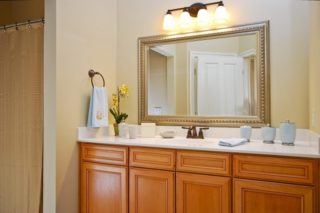
The main rule of choosing lighting in the bathroom is safety, since it is always humid here and there are power sources. When choosing devices, it is necessary to pay attention to the degree of protection against moisture.
If the room is small with low ceilings, you will have to use built-in spotlights, and additionally illuminate the mirror area so that it is convenient to carry out cosmetic events.
In a large bathroom, it is advisable to provide for zone lighting. Firstly, it looks beautiful, and secondly, it saves energy. For young children, you can always leave the small light bulb on so that they do not touch the sockets and switches. The most functional areas are a bathroom or shower, a place for sorting linen, a washbasin.
It is important how the lighting for the bathroom mirror is located. If it is one lamp in the top center, the image will be distorted, so you need to evenly distribute the light sources so that they are also on the sides.
Bathroom fixtures above the mirror should be as close to natural daylight as possible. This will allow women to adequately apply makeup, and men to carry out high-quality hygiene procedures.
The main types and functions of the backlight
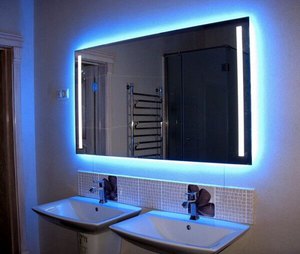
Each light source must perform several functions at the same time:
- create general lighting;
- perform a decorative function;
- if necessary, create directional lighting.
Several types of lighting can be used depending on the ceilings:
- LED;
- neon;
- using single chandeliers;
- point.
Each of them has its own advantages that can be combined in one room.
Design options and choices
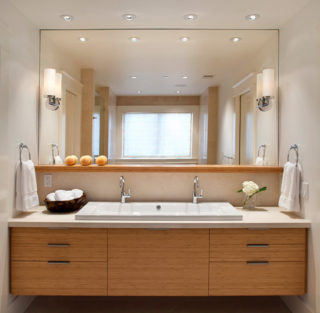
Depending on the location of the lamps, the backlight is:
- Contour. Spot lamps direct the light upward to create a continuous streak.
- Directional. These are more powerful sources that are located near the ceiling and direct the flow of light along it.
- Point. Lamps are installed in the ceiling in several places.
- Curly. The lamps are located in a certain ratio to each other.
- "Starry sky" - the arrangement of LED lamps is chaotic.
At the moment, the most popular are LED lamps, strips and lamps. Their service life is much longer than that of halogen or incandescent bulbs. The lamps are connected to a low voltage network, practically nothing affects their durability.
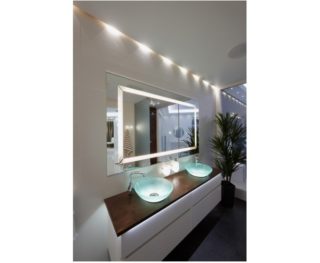
You can consider several design options for the bathroom:
- Illuminated skirting board.
- Illuminated cornice under the ceiling.
- Ceiling stained-glass windows from acrylic glass to the ceiling.
- Patterned glass ceilings under the light sources.
- Two-story ceilings with daylight effect.
The choice will depend on the height of the ceiling and its area, as well as the skill of the specialist who has to implement the design idea.
Criterias of choice
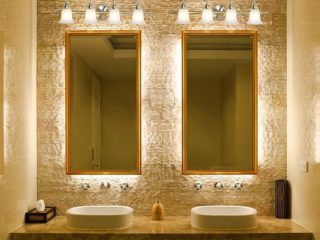
Bathroom lighting must meet the following requirements:
- Be functional, meaning each line of light must be interchangeable.
- Economy - It is better to use lamps that need to be changed rarely.
- Match the design of the room.
- Safety - lighting is installed in the bathroom with appropriate protection parameters.
- As close to daylight as possible.
With a small budget, it is not recommended to save on materials that will have to be changed often, as this will ultimately cost more.
Lifetime
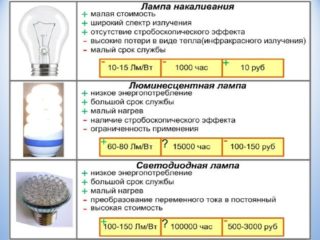
Incandescent lamps have a low service life, since at the moment of switching on the resistance of the spiral is many times less than in a hot one. Because of this, parts are subjected to stresses that reduce their service life.
LED bulbs operate at low voltage and do not receive heavy loads. The resource of their work is 30 thousand hours. After that, the bulbs do not burn out, just their brightness becomes lower and will be about 70% of the original. It is recommended to buy quality products, the service life of which corresponds to that stated in the instructions.
Fluorescent lamps last about 5 years if they are switched on no more than 5 times a day, and the total number of switches does not exceed 2000 times. The brightness of a fluorescent lamp is several times higher than that of an incandescent lamp of similar power.
Neon (gas-discharge) lamps have a resource of more than 80 thousand hours. The operating time is limited only by the quality of the glass that absorbs the sprayed electrodes. Bulb may rupture if used without a resistor.
The service life of halogen lamps is up to 4000 hours. When installing a dimmer, it can be increased to 12 thousand.
Safety

Depending on the production technology and the materials used, lamps affect vision in different ways. On sale you can find products that have a low color rendering index. With such lighting, eyes quickly get tired and visual acuity may even drop. Expensive high-quality lamps are recommended to be installed in those rooms where a person spends most of their time or works. In the bathroom, quality fixtures are essential to illuminate the mirror. For the rest of the zones, less expensive ones can be purchased.
Moisture resistance
Manufacturers produce lamps of various degrees of moisture resistance. This ensures the safety of people when using lighting fixtures with an increased level of moisture in the room. For the bathroom, you can purchase products with varying degrees of moisture protection. The closer the luminaire is to the water source, the higher the protection should be. If the bathroom is ventilated and condensation does not form, ceiling lamps may have minimal moisture protection, and groups of lamps above or around the bathroom should be safer.
Lighting lamp type
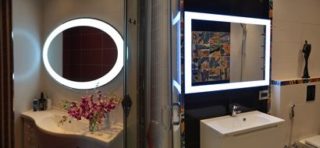
You can use different types of lighting lamps depending on the purpose - LED, fluorescent, incandescent. Due to their large resource, LEDs are suitable as work lighting, which will be switched on and off more often. Luminescent ones are suitable for certain areas, for example, near the bathroom, so that you can relax and the bright stream does not irritate the eyes. Incandescent lamps can be chosen as the main lighting located in the center of the ceiling - chandeliers or floor lamps.
Illuminated wall mirror
A good option to see your reflection well and reduce eye strain. Built-in illumination is usually located around the perimeter of the mirror, which creates an even stream. Such models are called dressing rooms, since they make it possible to evaluate the entire external image as a whole. When installing such a mirror, there is no need to look for a place near the window in order to evenly apply makeup.
Mirror cabinet
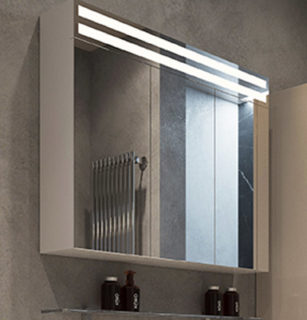
A backlit mirror cabinet in the bathroom can replace a spacious light dressing room, where you can appreciate yourself at full height. The main thing is that the lamps do not distort the image and do not create glare. To do this, it is necessary that there are no other working light sources in front of the mirror, and the illumination is located exclusively along the perimeter.
Illuminated and heated mirrors
Heating the mirror in the bathroom is necessary so that after water procedures the surface does not fog up and you can comfortably use it. In addition to condensation, a problem is the need to often wash the mirror surface, since after the dripping drops, traces remain.
The principle of mirror heating is based on the connection of wires, which are protected by a film. The system operates at 12 V, and the thermostat simultaneously acts as a step-down transformer. A mirror with a socket in the bathroom, which is equipped with a heating system, must be safe or have an earthing connection to drain the electricity.
Features of lamps for illuminating mirrors in the bathroom
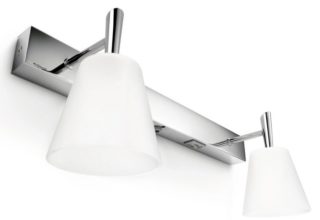
Since the bathroom, due to high humidity, is an extreme place for electrical appliances, it is necessary to take into account some of the features of such lamps:
- The devices have additional elements to protect the wire joints from moisture ingress. These are rubber seals in the shades, sealant plugs on the wires.
- The minimum IP value is 44, the maximum is 67.
- The devices are designed for installation by zone. There are 3 of them in the bathroom. In the first zone, the protection is maximum, the devices can be temporarily immersed in water - this will not cause harm. In the second zone, protection is not lower than index 45. In the third - 24 and higher.
All types of lighting devices have degrees of protection - LED, incandescent, fluorescent and halogen.
Lighting location
Luminaire durability
The durability of a bathroom luminaire is determined not only by the type of lamps, but also by the characteristics of the materials that can withstand prolonged operation in a humid mode with frequent temperature changes.
The most durable are metal and plastic, and plastic products are much cheaper than metal ones. Wooden parts with high humidity can deform and crack. Glass is a rather fragile material, but affordable if the repair budget is limited.
Internal parts made of quality materials extend the life of the products. Wire winding, metal grade or cable cross-section affect how long the luminaire will have a guaranteed lifespan. The higher the protection index, the longer the electrical appliance will last.
Lamp power
The higher the power of electrical appliances, the shorter the service life, so one powerful appliance can be installed in the bathroom, and the rest can be of medium or low power. It is recommended to connect them to different lines so that they turn on independently of each other. In case of failure of any group, the rest will perform their functions properly.
Reflector design
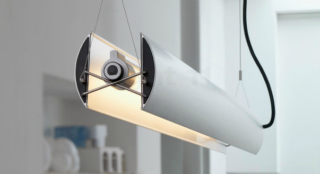
As a reflector of the luminous flux, the following can be used:
- mirror surfaces;
- aluminum;
- chrome surfaces;
- plastic with aluminum spraying.
Plastic reflectors are not very reliable as they heat up quickly. They need lamps that give off little heat - LED, halogen. Incandescent light bulbs can deform plastic or even cause a fire.
The thickness of the coating matters. For rooms with a non-aggressive environment - up to 3 microns, for a bathroom more will be required - up to 10 microns.
The matte finish creates a brighter light, the specular one absorbs the stream of photons. The shape of the reflector also affects the radiation intensity. Most often, a circle, ellipse or parabolic shape of the luminaire is used.
Can freestanding mirror lamps be used
If you need to hang a lamp in the bathroom above the mirror, and there are no wires for it, there is an option to equip autonomous lighting that will run on rechargeable batteries or batteries. This is not very convenient and economical, since the batteries need to be changed periodically, and the batteries need to be charged, but in the absence of other options, this will be optimal. The most economical in terms of energy consumption are LED lamps - they can be used in stand-alone light sources.
DIY installation and connection
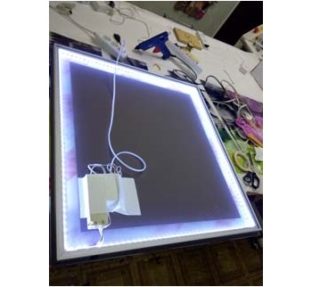
To begin with, a mirror is chosen according to the size of the bathroom and the desired shape - a square, a rectangle, an oval. The backlight will be located around the perimeter, it is applied using adhesive elements at the back or in a specially mounted box made of plasterboard, plastic, wood. The LED strip will be selected as the luminous element.
Additional materials will require:
- degreaser - alcohol or gasoline;
- wall mount for LED strip;
- material for the frame.
First, a box is constructed in which a mirror is placed. There should be a place at the back to secure the tape and the control unit. It is glued to any corner behind the mirror.
The wires are connected to the power supply, control button, tape and switch. At the same time, the button should be in a convenient place where it is easy to reach.
For installation in a damp room, all contacts must be tightly insulated with electrical tape and a hair dryer so that the insulation adheres to the wires. The voltage should be safe - 12 V. The LED strip should also be waterproof, and the power supply should not be in close contact with water - it is better to seal it in a film and hide it behind a mirror.









